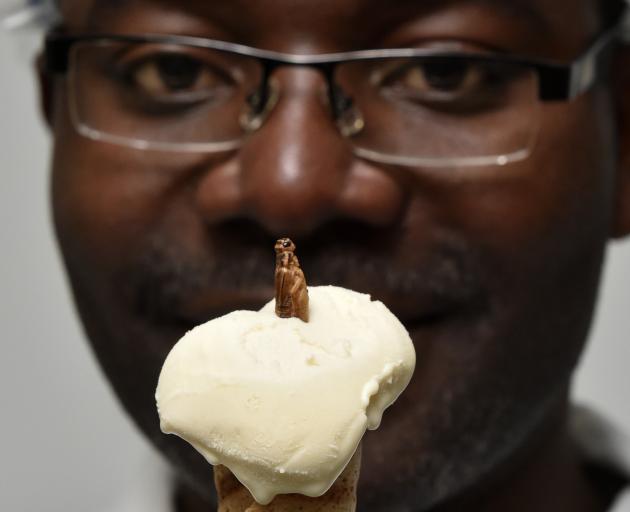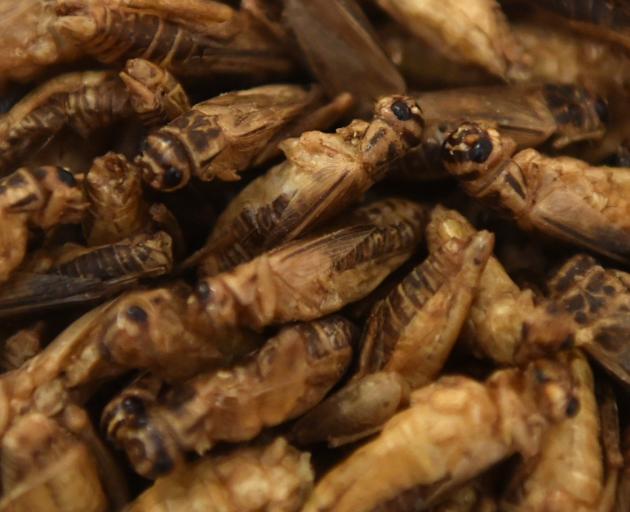Dried and roasted mealworms taste like dried shrimp. Fried cricket or grasshoppers are very crunchy.
Dr Dominic Agyei has loved all the insects he has tasted.
So it is not surprising the food scientist is keen to see the full potential of the crawly critters maximised as a food source.
"We believe insects are an important food with excellent nutrition for people of all ages and backgrounds."
However, sadly he believes one of the reasons people avoid eating insects is something researchers call the "yuck" factor so he and his colleagues want to show that they are far from being "yuck".

"Insects are actually tasty. And what better way to demonstrate this than by adding insect ingredients to ice cream - a dessert treat that is consumed by people of all ages and backgrounds. The aim is not to trick people into eating insects but to give them a treat doing so."
New Zealand lags behind many other nations in its use of insects as an easily accessible and affordable food source despite periodic blips in popularity such as in 2017 when a Dunedin bar and a restaurant began serving locally grown locusts as a crunchy snack. The company, Otago Locusts, then went on to win the novel food category at the New Zealand Food Awards.
Dr Agyei says insects are consumed regularly as part of the daily diet in many parts of the world.
"It is estimated that globally, about two billion people in over 300 ethnic groups and about 130 countries eat insects almost daily. In some parts of the world for example Thailand, China, and Mexico, one can buy insects on the streets, much like how fish and chips are widely available on many streets in Dunedin."

One of the reasons for their popularity in other parts of the world is that insects are nutritious as they are rich in important nutrients like proteins, fat, and minerals.
"These nutrients can be present at levels similar to or better than what one finds in meat, for example. But insects have one nutritional advantage over meat: insects, especially adult insects, contain an exoskeleton that is made from chitin, which is considered a dietary fibre and good for gut health. Insects are probably the only animal-based food that contains supply dietary fibre in diets."
Insects also taste different depending on their type and whether they are a larvae or adult.
For the average New Zealander, cost is another barrier to regularly incorporating insects in their cooking. Auckland company Eat Crawlers sells insect snacks, cricket flour and pasta but a 250g packet of penne costs $11.99 and 50g of flour $12.99. They source their insects from farms in Asia.
"The reason is that the market is still small, so the current cost of insects is quite expensive, especially compared to other protein sources such as meat."
At the University of Otago food science workshop, participants will get to taste ice cream, made just like "normal" ice cream, but with cricket flour included in the mix.
"We chose cricket because it is one of the insects easily sourced from Eat Crawlers, does not have an ‘overpowering’ taste, and also has an excellent nutritional profile."
In asking people to try the ice cream, Dr Agyei will not be asking anything he has not done himself.
"I have tried several insects and loved them all. Dried and roasted mealworms taste like dried shrimp. Fried cricket or grasshoppers are very crunchy and yummy."

"Contrary to what most people think, huhu grub does not taste like peanut butter; it only feels that way in the mouth. The taste itself is quite mild, even when fried."
Dr Agyei’s taste in insects has been developed out of research interest in how indigenous foods contribute to food security and health. With a degree in food science he moved on to do his doctorate in bioprocess engineering, an arm of chemical engineering that deals with how to use biological materials and processes to create something of value. For example, the application of engineering principles to develop products like vaccines, antibiotics, and in Dr Agyei’s case functional foods.
He believes insects will play a huge role in the food system in the future because they will diversify food and feed sources. Not only are they nutritious but the rearing of edible insects (also called mini-livestock) improves biodiversity and can be a lucrative low-resource enterprise.
"Insects emit less quantities of greenhouse gases, and some can thrive on a wide variety of diets (including food waste). Additionally, using insects as food could reduce our reliance on insecticides to control them. In other words, “if you can’t beat them, eat them”.
As people become more aware of the benefits of insect consumption, they seem to get more interested in them, he believes.
Recently, the European Food Safety Authority approved yellow mealworms as safe to be produced and sold for human consumption. This means the technology for mass production and international trade of safe edible insects is expected to grow.
"In the past few decades, it was estimated that there are about 2100 species of insects that at edible. Newer research seems to challenge these figures and says there are probably around 1600 edible insect species. That is still a lot of variety to choose from."
While there is solid evidence insects are nutritious, good for people’s health and the environment, more work is needed in consumer insights to get more people to eat them regularly.
"We need more data to understand the social and psychological factors that control people’s motivation to try novel foods."
That is needed as without consumer buy-in, the many benefits of insects as a food source cannot be realised.
"A bigger market will drive interest from entrepreneurs and researchers, which can drive prices down for the consumer."

• Otago Locusts’ Malcolm Diack says he now has the growing pains of the early days of his business sorted so he now has a sustainable population of locusts to supply buyers.
The downturn in the restaurant industry during Covid meant interest in novel food items also tanked but he hoped that would come back as the hospitality sector improved.
Instead he is supplying live or frozen locusts to zoos and owners of reptiles and amphibians. Occasionally he gets an inquiry from the public for an event they are hosting.
It has become his fulltime job and he is looking to expand into processed food products so he is working on creating space for that on his property.
"It’s exciting."
He sees processed products as the way to reach the general public as it avoids the "yuck" factor. The powdered locusts he is trialling look like cocoa powder but smell different.
"I’ve just got to get them ready to eat, shelf stable and make sure they’re tasty."
Mr Diack is appreciative of the work Dr Agyei and his colleagues are doing in researching different ways insects can be produced and eaten as a food source.
"It’s taking it to the next level."
That was important as it is a very low greenhouse gas-emitting industry as well with less than 1kg of carbon dioxide produced per 100g, much lower than that of other protein sources.
TO SEE
Edible Insects: Treat or Trick?
Saturday July 8, 2pm-4pm,
University of Otago - Food Science
Portcom Lab, 65A Union Place,
Dunedin North












